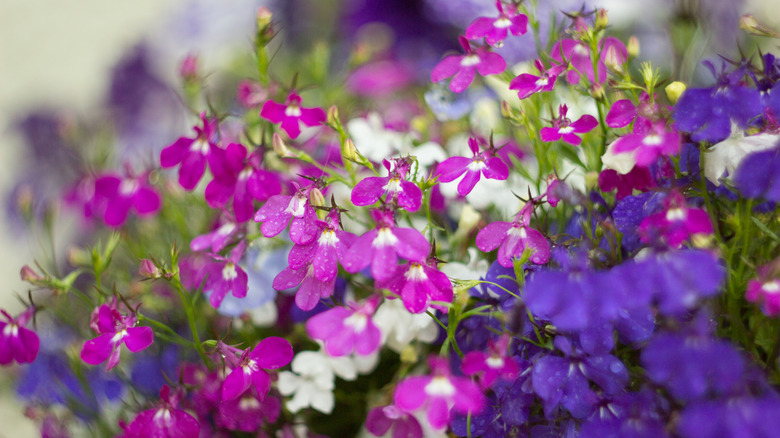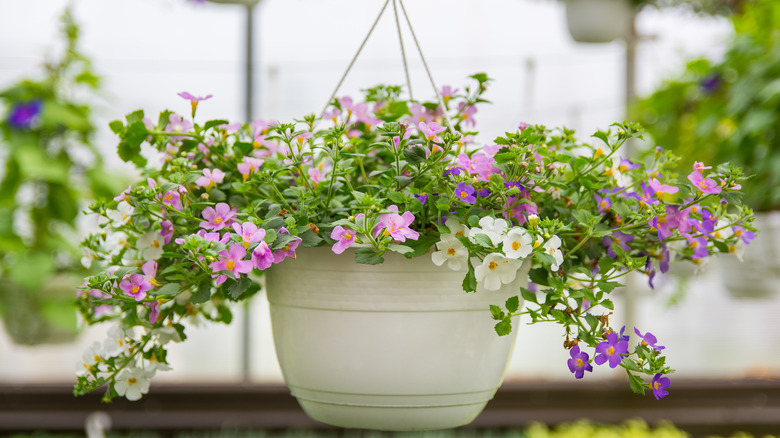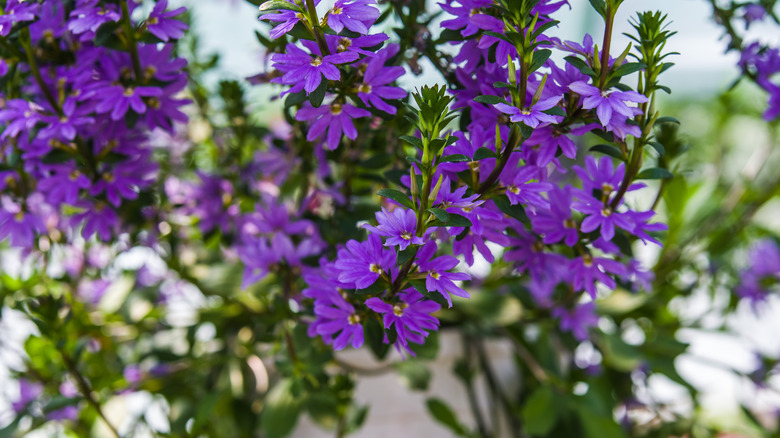Nothing is more inviting than a porch decorated with flowers. Hanging flowering plants have an added advantage because they don’t take up space on the floor, and they’re simply gorgeous. You can hang several plants from your porch, and the best thing is you won’t have to worry about weeding them! In addition, you won’t have to worry so much about pests with hanging plants because they are off the ground.
That being said, plants in hanging pots tend to have a tendency to dry out (especially if they are in a sunny location), so you will need to check the soil often. Hanging pots need to have drainage holes to prevent plants from getting root rot, which is another reason why you should be diligent when it comes to keeping an eye on how dry the soil gets between waterings. Hanging plants also tend to overgrow, so to keep them looking their best, you’ll need to trim most of them, per Garden Therapy. If you follow these tips along with individual plant recommendations for fertilization, you’ll have your porch looking like a floral masterpiece all summer long.
1. Begonias

Begonias (Begonia) are perfect for hanging baskets because they do well in shade and sun. From orange to red to white, their bright blooms last all summer long. They like soil that drains easily, but they do not tolerate dry soil well, so keep an eye on it. The University of Minnesota notes that some direct sun won’t harm begonias, but otherwise, they need indirect light.
Sunlight Needs: early morning and late evening sun is best with indirect light most of the day
Water Needs: allow soil to dry in between waterings
2. Black-eyed Susan vine

Black-eyed Susan vine plants (Thunbergia alata) produce bright yellow and pink flowers with dark centers. The blooms form along vines, and they will last well into fall. The vines can even grow up to 8 feet long, according to The Spruce. They do best in a rich soil that retains a little bit of water.
Sunlight Needs: full sun to partial shade, but avoid direct sun on hot afternoons
Water Needs: water regularly, keeping the soil moist
3. Million bells

Klever_ok/Shutterstock
Million bells (Calibrachoa) live up to their name, offering up lots of tiny blooms that come in a wide range of colors. These plants do best in soil that drains well, and they can bloom from the fall until the first frost of the year. In fact, they do best in cooler temperatures. An added plus is that million bells drop dead blooms so you don’t have to remove them, per HGTV.
Sunlight Needs: six hours of sun per day, but they do well in shady areas on hot afternoons
Water needs: water when the top inch of soil feels dry, and allow to dry out between waterings
4. Twinspur

Amehime/Shutterstock
Twinspurs (Diascia) come in a variety of sizes and colors. From dwarf to large sizes, colors range from salmon to purple. You’ll need to trim the dead blooms to encourage growth. In the summer, you’ll also need to trim back the plant to anywhere between 4 inches and 10 inches after the blooming stage to foster growth, per Gardening Know How. Twinspurs are known to bloom in autumn after a summer bloom.
Sunlight Needs: full sunlight, but prefers afternoon shade in hot weather
Water Needs: water regularly and deeply when the soil feels dry
5. Impatiens

The Old Photographer/Shutterstock
Delicate and beautiful, impatiens (Balsaminaceae) are popular because they are relatively easy to care for. They do well in shaded areas with low lighting, so if you have an area on your porch that gets a good amount of shade, this is the plant for it. You will need to trim your impatiens to encourage growth, according to Garden Guides.
Sunlight Needs: bright, indirect light
Water Needs: water thoroughly until soil is moist, and water when soil becomes slightly dry
6. Nasturtium

mcajan/Shutterstock
If you’re looking for a colorful blooming plant that does well despite a little bit of neglect, then a basket of Nasturtium (Tropaeolum majus) might be exactly what you’re looking for. These plants don’t need a lot of water, they don’t suffer from pests infestations, and they can thrive in poor soil, according SF Gate.
Sunlight Needs: bright light, but they can do well in partial shade
Water Needs: water when the top 2 inches to 3 inches of soil feel dry, and until water drains from bottom of pot
7. Ivy geraniums

Denys R/Shutterstock
Another colorful plant that is relatively easy to care for is ivy geraniums (Pelargonium peltatum). There are several varieties in many different colors, and they all add pops of color to any porch. Ivy geraniums are sensitive to high temperatures, and won’t bloom when it gets too hot. However, when it cools off, they will begin blooming again, per Hunker. When blooms are dead, remove them to encourage new growth.
Sunlight Needs: morning sun and afternoon shade
Water Needs: water when soil is dry to touch, and avoid getting foliage wet
8. Lobelia

beatraxa/Shutterstock
When it comes to producing an abundance of blooms, it is hard to compete with lobelia (Campanulaceae) plants. Available in a variety of colors and as perennials or annuals, lobelia flowers feature five-lobed blossoms that bloom in the summer. After the first blooms of the season, trim the plant back about an inch to stimulate more blooms. To keep lobelia plants blooming all summer, you’ll want to pinch off any dead flowers, says Plant Care Today.
Sunlight Needs: morning sun and afternoon shade
Water Needs: keep the soil moist, watering daily if necessary
9. Verbena

Olga Gorevan/Shutterstock
Another plant that will liven up your porch is the Imagination Verbena (Verbenaceae). The blooms on these aromatic plants are small and plentiful, and they can bloom from early spring to early autumn. Verbenas are fairly easy to care for with most problems arising from too little sunlight or poorly draining soil, per Garden Design. Place them in a sunny location to foster plenty of blooms.
Sunlight Needs: full sun
Water Needs: water regularly in a pot that drains well
10. Hanging fuchsia

Andriy Blokhin/Shutterstock
Fuchsias (Onagraceae) might be some of the most interesting plants to have hanging on your porch, and the good news is they are not hard to care for. The flowers are bell-shaped with petals that project a hanging bloom underneath. Different varieties offer several colors, with bright purple being a favorite. The flowers are tender, so keep them protected from wind and rain, advises Gardeners World.
Sunlight Needs: full sun
Water Needs: keep well-drained soil moist
11. Bacopa

Edgars Melkis/Shutterstock
For a bright white pop, you cannot go wrong with Bacopas (Sutera). These plants grow quickly once the temperatures warm up, and you won’t even need to remove dead blooms to keep it going throughout the season. If you see any yellow leaves, it probably needs water. Better Homes & Gardens notes that if they go for just a couple of days without water, they may stop blooming, but once you water them, they will begin blooming again.
Sunlight Needs: full sun to partial sun
Water Needs: water regularly and keep the soil moist
12. Lantana

Nopparat Khokthong/Shutterstock
Like the Bacopa, lanatas (Verbenaceae) grow fast and can brighten up your porch with color in almost no time. The blooms are a cluster of smaller flowers that come in a variety of colors. The plants are hardy, and they bloom from early spring until fall welcomes the first frost. Trim the plants back to stimulate more blooms. Avoid getting the foliage wet when watering because this could invite mold and mildew, warns Clemson Cooperative Extension.
Sunlight Needs: full sun
Water Needs: water about once a week
13. Trailing pansies

Tami Freed/Shutterstock
Trailing pansies (Violaceae) are a somewhat new iteration of traditional pansies. They like to spread, which makes them perfect for a hanging basket. Southern Living recommends planting half as many as you normally would in a pot because they grow rapidly, and will overcrowd each other if you don’t. Trailing pansies are hardier than regular pansies and can bloom in temperatures as low as 40 degrees, as long as you keep them well fed.
Sunlight Needs: full sun to partial shade
Water Needs: keep soil moist
14. Moss roses

pensandoenmon/Shutterstock
Moss Roses (Portulaca grandiflora) are available in several colors, and they are fairly easy to grow as long as they get enough light. They can tolerate a little neglect when it comes to watering, and they prefer a drier, sandy soil that drains well, according to Martha Stewart. Moss roses are toxic to dogs, so be sure to keep them hung high.
Sunlight Needs: full sun, at least six hours a day
Water Needs: when the soil is dry
15. Fan flower

Sirle Kabanen/Shutterstock
The fan flower (Scaevola Aemula) is a cascading plant that will look gorgeous hanging on your porch. As the name implies, the flowers are fan shaped, and come in shades of purple, pink, white, and blue. They bloom in the summer months and you can keep them blooming all summer long by removing the dead flowers. To keep fan flowers from developing root rot, keep them in well-drained soil, per Texas Tech University.
Sunlight Needs: full sun
Water Needs: when soil feels dry



